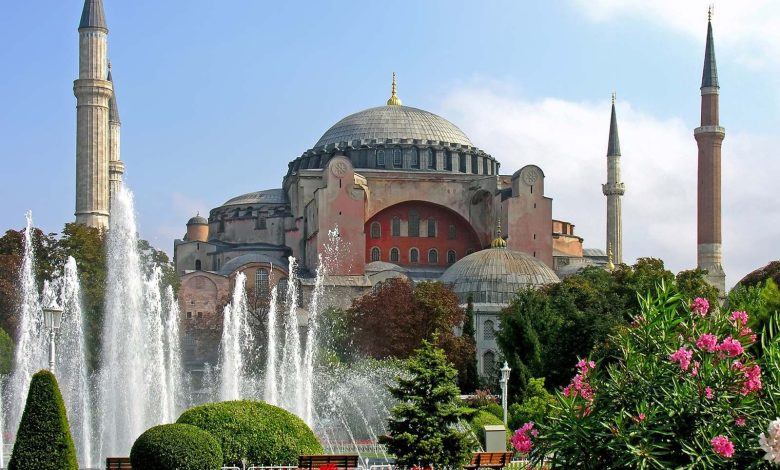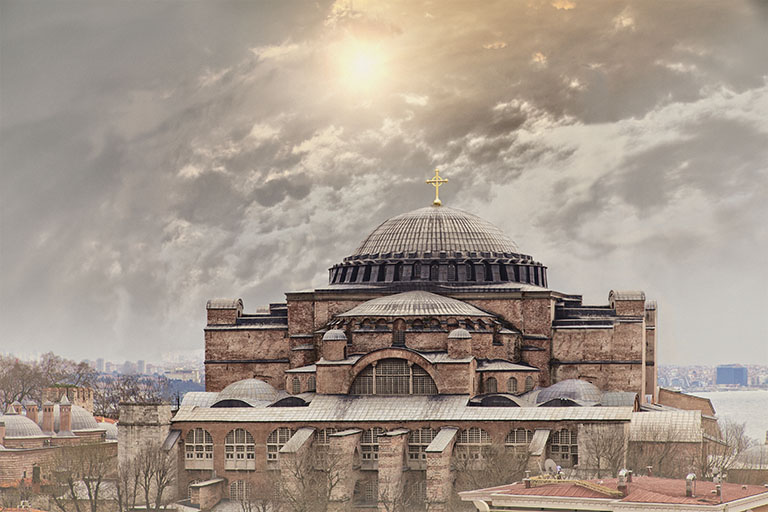Hagia Sophia History.

Hagia Sophia is a historic architectural marvel in Istanbul, Turkey. It served as a cathedral, mosque, and now a museum.
Hagia Sophia’s history spans over 1,500 years, reflecting a rich and diverse cultural heritage. Originally constructed in 537 AD by Byzantine Emperor Justinian I, it was the world’s largest cathedral for nearly a thousand years. Its majestic dome and intricate mosaics exemplify Byzantine architecture.
In 1453, Ottoman Sultan Mehmed II converted it into a mosque, adding minarets and Islamic art. In 1935, it became a museum, symbolizing Turkey’s secularism. Hagia Sophia’s recent reversion to a mosque in 2020 sparked global discussions. This iconic structure remains a testament to the blend of Christian and Islamic civilizations.

Credit: en.wikipedia.org
Origins And Early Construction
The Hagia Sophia stands as a beacon of ancient architectural genius. Its history dates back to the Byzantine Empire. This section delves into its origins and early construction.
Byzantine Empire’s Vision
The Byzantine Emperor Justinian I sought to build a grand church. He wanted it to symbolize the empire’s power and faith. The construction began in 532 AD. The location was chosen in the heart of Constantinople.
Justinian’s vision aimed to surpass all existing churches. The previous church on the site had been destroyed. The new Hagia Sophia would be larger and more magnificent.
Architectural Innovations
The Hagia Sophia showcased many architectural innovations. Architects Anthemius of Tralles and Isidore of Miletus led the project. They introduced a unique combination of a basilica and a dome.
The massive central dome was an engineering marvel. It measured 31 meters in diameter. The dome appeared to float, supported by pendentives. This was a groundbreaking technique at the time.
The interior was adorned with mosaics and marble pillars. The materials were sourced from across the empire. The Hagia Sophia’s beauty and scale were unprecedented.
| Feature | Details |
|---|---|
| Location | Constantinople (now Istanbul) |
| Construction Start | 532 AD |
| Architects | Anthemius of Tralles, Isidore of Miletus |
| Dome Diameter | 31 meters |
Hagia Sophia’s early construction set new standards. Its architectural innovations influenced future structures. The legacy of its origins continues to inspire awe.

Credit: www.pallasweb.com
Transformation Into A Mosque
The Hagia Sophia has a rich and varied history. Originally, it was a grand basilica. Its transformation into a mosque marks a significant chapter. This transformation happened under the Ottoman Empire.
Ottoman Conquest
The Ottoman Empire conquered Constantinople in 1453. Sultan Mehmed II led this conquest. He is also known as Mehmed the Conqueror. After the victory, he entered the Hagia Sophia. He decided to convert it into a mosque. This decision marked a new era for the building.
On May 29, 1453, the first Islamic prayer took place. This event symbolized the start of a new chapter. The conversion was quick and efficient. The Ottomans respected the building’s grandeur. They aimed to preserve its beauty while adding Islamic elements.
Islamic Architectural Additions
Several significant changes were made to the Hagia Sophia. These changes were to reflect Islamic traditions:
- Minarets: Four minarets were added around the structure.
- Mihrab: A mihrab was installed to indicate the direction of Mecca.
- Minbar: A minbar was placed for the imam to lead prayers.
- Calligraphy: Arabic calligraphy adorned the walls.
Each addition was carefully planned. The goal was to blend Islamic art with the existing Byzantine architecture. This created a unique and harmonious aesthetic.
The Hagia Sophia served as a mosque for nearly 500 years. It became a symbol of Istanbul’s Islamic heritage. The transformation is a key part of its long and storied history.
Modern Era And Museum Status
The Hagia Sophia, an iconic symbol of Istanbul, has a rich modern history. Originally a cathedral, it became a mosque in 1453. In 1935, it was secularized and turned into a museum. This move was part of Turkey’s modernization efforts. The transition to a museum status marked a significant shift.
Secularization Efforts
In the early 20th century, Turkey underwent significant changes. Mustafa Kemal Atatürk led the country through a series of reforms. Among these was the secularization of the Hagia Sophia. In 1935, it officially became a museum. This change aimed to promote cultural harmony.
As a museum, the Hagia Sophia welcomed people of all backgrounds. It showcased Byzantine mosaics and Ottoman features. The secular status emphasized its historical and architectural importance. This period marked a new chapter in its rich history.
Tourist Attraction
The Hagia Sophia quickly became a major tourist attraction. Visitors from around the world flocked to see its grandeur. The building’s unique blend of architectural styles drew much attention. People admired the intricate mosaics and vast domes.
Here are some key highlights:
- Byzantine mosaics depicting Christian icons
- Ottoman calligraphy and Islamic features
- Massive dome with a diameter of 31 meters
- Historical significance spanning multiple empires
Visitors can explore various sections of the Hagia Sophia. The main hall, galleries, and upper levels offer much to see. Its status as a museum allowed for extensive preservation efforts. This ensured that future generations could appreciate its beauty.
Recent Developments
The Hagia Sophia has seen many changes. The most recent is its reconversion to a mosque. These changes have influenced its cultural significance today.
Reconversion To Mosque
In 2020, the Turkish government decided to reconvert Hagia Sophia into a mosque. This decision caused international reactions. Many people debated its cultural impact.
Before 2020, Hagia Sophia was a museum for 85 years. The reconversion was a significant historical event. People from all over the world watched it closely.
| Year | Change |
|---|---|
| 1935 | Converted to Museum |
| 2020 | Reconverted to Mosque |
Current Cultural Significance
Hagia Sophia remains a symbol of Istanbul. Its architectural beauty attracts many visitors. It holds great cultural and historical value.
Today, Hagia Sophia serves as both a mosque and a tourist attraction. This dual role adds to its unique charm. It continues to be a place of worship and a historical site.
The building’s rich history and stunning architecture make it a must-see for anyone visiting Istanbul. Whether you come to pray or admire its beauty, Hagia Sophia welcomes all.

Credit: www.britannica.com
Frequently Asked Questions
What Is The Hagia Sophia?
Hagia Sophia is a historic architectural marvel in Istanbul, Turkey.
Who Built The Hagia Sophia?
Emperor Justinian I commissioned its construction in 537 AD.
Why Was The Hagia Sophia Built?
It was built as a cathedral for the Eastern Orthodox Church.
What Is Hagia Sophia Used For Today?
Today, it serves as a museum and a mosque.
Conclusion
Hagia Sophia stands as a testament to architectural brilliance and historical significance. Its rich history attracts millions of visitors annually. Exploring its past offers deep insights into Byzantine and Ottoman cultures. Visiting this iconic monument provides a unique glimpse into centuries-old traditions and artistry.
Discover the timeless allure of Hagia Sophia today.


